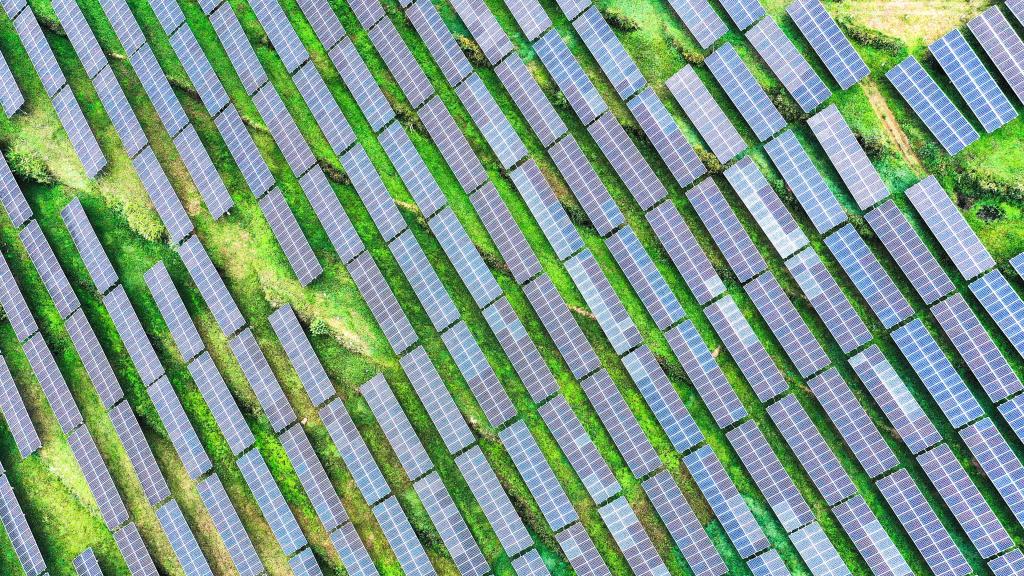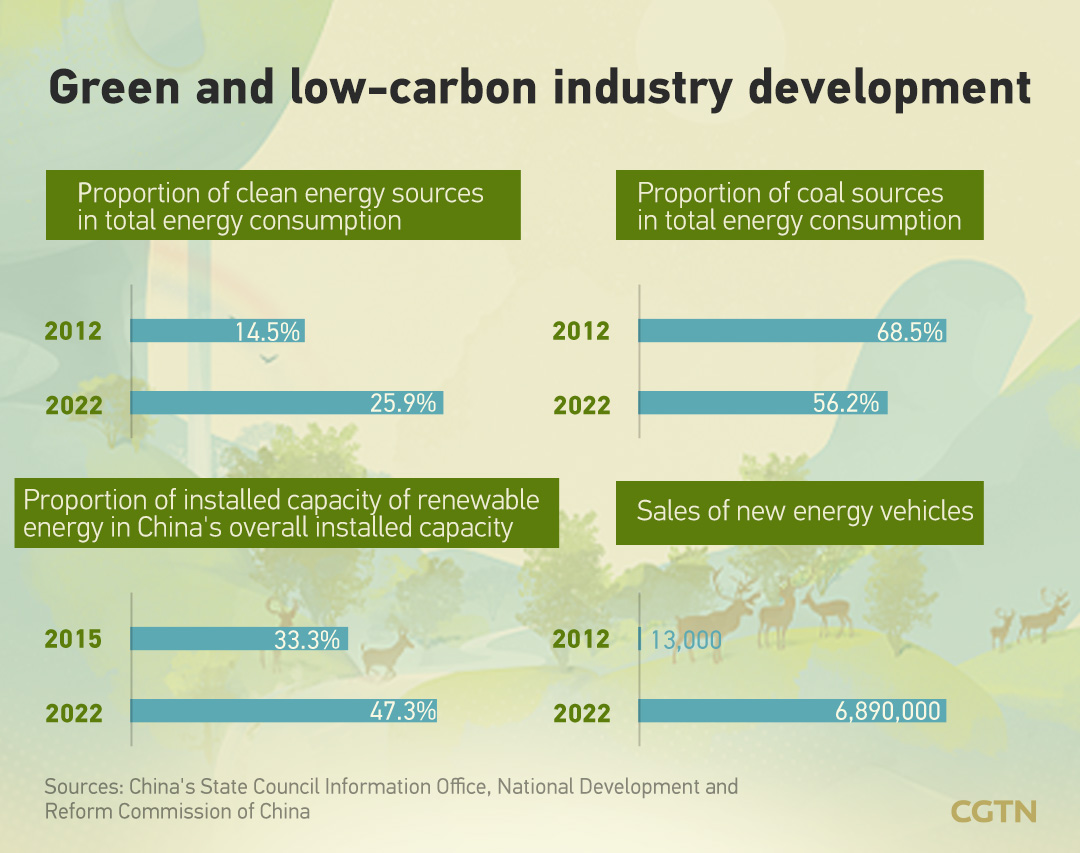
This aerial photo shows a photovoltaic power plant in Weining Yi, Hui and Miao Autonomous County, southwest China's Guizhou Province, July 20, 2023. /Xinhua
This aerial photo shows a photovoltaic power plant in Weining Yi, Hui and Miao Autonomous County, southwest China's Guizhou Province, July 20, 2023. /Xinhua
China is strengthening its efforts to accelerate its all-round green transformation by developing green technologies, transforming energy-intensive industries to low-carbon industries, reforming institutions and legislation, and scaling up ecological environment protection.
China's top legislature, ministries and other key national commissions made intensive moves on Tuesday by holding activities, issuing new policies or making pledges and statements to show their resolution to boost the country's green development as August 15 marked China's first National Ecology Day.
The day was designated by the Standing Committee of the National People's Congress (NPC) in June, with the aim of improving public awareness of ecological protection and promoting China's green, sustainable and low-carbon development.
Zheng Shanjie, head of the National Development and Reform Commission (NDRC), said on Tuesday that policies and measures to promote comprehensive green transformation of economic and social development will soon be formulated by the commission, and their focus is to reform key sectors to reduce carbon emissions, improve energy efficiency and establish a national waste recycling system.
To help achieve China's dual carbon goals, Zheng said that the commission will fulfill its coordination responsibility by accelerating the planning and implementation of a new energy system, improving economic policies for green and low-carbon development, and advancing green technology innovation.
In April 2021, China pledged to the world that the country will strive to peak carbon dioxide emissions before 2030 and achieve carbon neutrality before 2060. The pledges are known as China's dual carbon goals.
According to Zheng, China's new energy vehicles and photovoltaic industries are developing rapidly. The latest data from the NDRC shows that the proportion of clean energy sources in total energy consumption increased from 14.5 percent in 2012 to 25.9 percent by the end of 2022, and the proportion of coal dropped from 68.5 percent to 56.2 percent over the same period.
By the end of 2022, the sales of new energy vehicles jumped to 6.89 million, ranking first for eight consecutive years in the world. In 2012, the sales of new energy vehicles were 13,000, said the NDRC.

Ding Zhijun, deputy director of the Energy Conservation and Comprehensive Utilization Department of the Ministry of Industry and Information Technology (MIIT), pledged at an environmental protection forum on Tuesday that the ministry would accelerate the establishment of a green manufacturing system and a green and low-carbon technology support system.
"Developing green industries is vital for the green transformation and upgrading of traditional manufacturing industries," said Ding, adding that "it will also promote the development of strategic emerging industries and create new economic growth points."
According to Ding, China's industrial structure in recent years has been continuously optimized and upgraded, and the efficiency of energy and resource utilization has been further improved.
Official data from the MIIT shows that since 2021, China's energy consumption of industrial added value has decreased by 6.9 percent and the output value of the environmental protection equipment manufacturing industry in 2022 increased by 2.2 percent year on year, reaching 960 billion yuan ($131.5 billion).
Meanwhile, the Legislative Affairs Commission of the NPC Standing Committee noted on Tuesday that to better protect the environment, the NPC Standing Committee has formulated and revised 19 laws since 2012, including laws on protecting the country's major rivers, wetlands and the Qinghai-Xizang Plateau. The legislation also increased penalties for violations of relevant laws and regulations.
Currently, China has in place more than 30 laws, over 100 sets of administrative regulations and many local regulations focused on eco-environmental protection, said the top legislature.
China's Supreme People's Court (SPC) on Tuesday released new judicial interpretations on a set of specific issues regarding environmental violation cases.
The judicial interpretations further prescribe the applicable scope and accountability principles of cases involving environmental infringement liability disputes, including the multiple-violator scenario, among other issues. The documents also specify content such as the collection and protection of evidence, and loss assessment in civil environmental lawsuits.

Aside from documents, policies and laws, other actions have also been taken to help fulfill China's dual carbon commitment, including constructing green energy projects and afforestation.
One of China's green energy projects is the six mega hydropower stations on the Yangtze River: Wudongde, Baihetan, Xiluodu, Xiangjiaba, Three Gorges Dam, and Gezhouba. Together, they form the world's largest clean energy corridor, expected to generate 300 billion kilowatt-hours of clean electricity annually. This amount can meet the annual electricity demand of 360 million people, equivalent to a quarter of China's population.
And according to a press briefing by the forestry bureau of south China's Guangxi Zhuang Autonomous Region on Tuesday, the region has adopted various ways to add greenery and promote carbon sink capacity, including strengthening afforestation in key river basins and developing economic forests.
The forestry bureau said that Guangxi has added an annual average of more than 3 million mu (200,000 hectares) of afforested area for 15 consecutive years, and the planted forest area in the region so far has hit 134 million mu, accounting for about 10 percent of the country's total.
Besides, the region's grassland vegetation coverage rate has reached 82.9 percent, and the rocky desertification land area in the region decreased by 7.2 million mu compared with 2016, said the bureau.
Read more:
Chart of the Day: China has achieved remarkable progress in eco-environmental construction